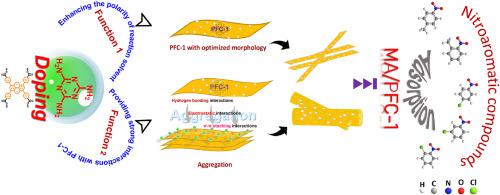Analytica Chimica Acta ( IF 5.7 ) Pub Date : 2023-07-26 , DOI: 10.1016/j.aca.2023.341652 Yalan Hu 1 , Yuefan Liu 1 , Yixin Kuang 2 , Suxin Zhou 2 , Luyi Chen 3 , Ningbo Zhou 1 , Juan Zheng 4 , Gangfeng Ouyang 5

|
Enrichment and detection of trace pollutants in the real matrix are essential for evaluating water quality. In this study, benefiting from the good affinities of 1,3,6,8-tetra(4-carboxylphenyl)pyrene) (H4TBAPy) with itself and melamine (MA) respectively, the composite hydrogen-bonded organic frameworks (HOFs, MA/PFC-1), PFC-1 self-assembled by 1,3,6,8-tetra(4-carboxylphenyl)pyrene), were successfully constructed by the mild strategy of solvent evaporation at room temperature. Through a series of characterizations, such as Fourier transform infrared spectra, X-ray diffraction, thermal gravimetric analyses, and N2 adsorption-desorption, etc., the MA/PFC-1 was confirmed to be a stable and excellent material. In addition, it possessed high surface area, hierarchical micropores, strong hydrogen bonds, and rich function groups containing N and O heteroatoms, since the newly introduced MA could be another hydrogen bonding motif, as well as increased the polarity of reaction solvent. These advantages make MA/PFC-1 be an ideal coating material for solid phase microextraction (SPME). Satisfactory enrichment factors for nitroaromatic compounds (NACs) were got by the MA/PFC-1 fiber under the optimized conditions obtained by the control variables (extraction time of 60 min, extraction temperature of 80 °C, desorption time of 6 min, desorption temperature of 260 °C, pH value of 7, and stirring speed of 250 rpm). MA/PFC-1 was further used to develop an analytical method for NACs based on head-space SPME coupled with gas chromatography‒mass spectrometry (GC‒MS). The developed method with low limits of detection (4.30–20.83 ng L−1) and good reproducibility (relative standard deviations <8.6%). The excellent performance allowed the successful application of the developed method in the determinations of trace NACs in real water samples with recoveries of 80.1%–119%. This study proposed a mild approach to synthesize composite HOFs via doping MA and developed an environmentally friendly method for the precise determinations of NACs in the environment.
中文翻译:

具有强氢键和分级微孔的三聚氰胺参与氢键有机框架驱动硝基芳香族化合物的萃取
真实基质中痕量污染物的富集和检测对于评价水质至关重要。在本研究中,受益于1,3,6,8-四(4-羧基苯基)芘)(H 4 TBAPy)分别与其自身和三聚氰胺(MA)良好的亲和力,复合氢键有机骨架(HOFs, MA/PFC-1),即由1,3,6,8-四(4-羧基苯基)芘)自组装的PFC-1,通过室温溶剂蒸发的温和策略成功构建。通过傅里叶变换红外光谱、X射线衍射、热重分析、N 2吸附-脱附等一系列表征,证实MA/PFC-1是一种稳定且优异的材料。此外,由于新引入的MA可能是另一个氢键基序,因此它具有高表面积、分级微孔、强氢键和丰富的含有N和O杂原子的官能团,并增加了反应溶剂的极性。这些优点使MA/PFC-1成为固相微萃取(SPME)的理想涂层材料。在控制变量(萃取时间60 min,萃取温度80℃,解吸时间6 min,解吸温度)得到的优化条件下,MA/PFC-1纤维对硝基芳香族化合物(NACs)获得了满意的富集因子260℃,pH值7,搅拌速度250rpm)。MA/PFC-1 进一步用于开发一种基于顶空 SPME 与气相色谱-质谱联用 (GC-MS) 的 NAC 分析方法。所开发的方法具有低检测限(4.30–20.83 ng L -1)和良好的重现性(相对标准偏差<8.6%)。优异的性能使得所开发的方法成功应用于实际水样中痕量 NAC 的测定,回收率为 80.1%–119%。本研究提出了一种通过掺杂MA合成复合HOF的温和方法,并开发了一种环境友好的方法来精确测定环境中的NAC。
















































 京公网安备 11010802027423号
京公网安备 11010802027423号